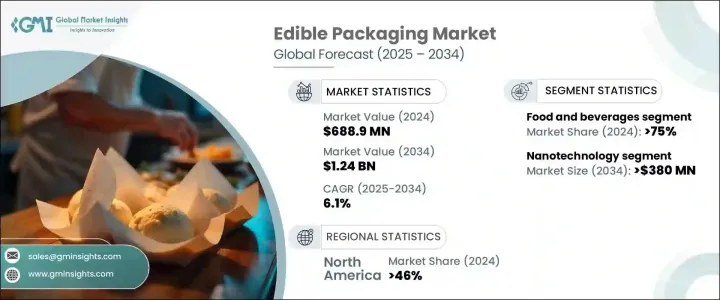
식용 포장 세계 시장은 2024년에 6억 8,890만 달러에 이르렀으며, 2025년부터 2034년에 걸쳐 6.1%의 연평균 복합 성장률(CAGR)로 성장할 것으로 예측되고 있습니다.
이러한 현저한 성장은 플라스틱 오염에 대한 우려가 세계적으로 커지고 있는 가운데, 지속가능하고 환경친화적인 패키징 솔루션에 대한 수요가 높아지고 있는 것이 주요 요인입니다. 환경문제가 논의의 중심을 차지하고 있는 가운데, 기업과 소비자는 기존의 포장방법을 대체하는 것을 점점 요구하고 있습니다. 식용 포장은 세계의 지속가능성 목표에 따라 폐기물이없는 생분해 성 옵션을 제공함으로써 유망한 해결책을 제시합니다. 게다가 의식이 높은 소비자주의로의 변화가 증가하고 환경 실적를 줄이는 포장 솔루션에 대한 요구가 시장 확대에 박차를 가하고 있습니다. 지속가능한 생산 공정에 대한 관심과 혁신적인 소재의 상승은 이 시장의 가속화를 더욱 뒷받침하고 식용 포장을 포장 기술의 미래에 중요한 선수로 자리매김하고 있습니다.

시장은 최종 용도산업별로 구분되며, 2024년에는 식음료 섹터가 75%의 압도적 점유율을 차지했습니다. 이 이점은 환경 친화적 인 제품에 대한 소비자의 선호도 증가로 인한 것입니다. 소비자가 보다 지속가능한 선택을 추구하는 동안, 식음료 산업은 폐기물을 줄일 뿐만 아니라 환경 의식이 높은 소비자에게 어필하는 방법으로 보고 식용 포장을 빠르게 채택하고 있습니다. 이러한 패키징 솔루션은 기능과 환경 친화성을 양립하기 위해 개발되었으며 제품 품질을 저하시키지 않으면서 편리한 대안을 제공합니다. 한편, 제약 업계도 식용 포장의 가능성을 이용하고 있지만, 점유율은 작고 틈새 응용에 대응하고 있습니다.
| 시장 범위 | |
|---|---|
| 시작 연도 | 2024년 |
| 예측 연도 | 2025-2034년 |
| 시작금액 | 6억 8,890만 달러 |
| 예측 금액 | 12억 4,000만 달러 |
| CAGR | 6.1% |
포장 공정의 관점에서 시장은 항균, 나노 기술, 전기 유체 역학, 코팅, 미생물로 분류됩니다. 그 중에서도 나노기술 분야는 눈부신 성장을 이루고 CAGR 6.5%로 성장할 것으로 예상됩니다. 2034년까지 식용 포장의 나노기술은 3억 8,000만 달러 시장 가치를 창출할 것으로 예상됩니다. 이 기술은 분자 수준에서 재료 특성을 향상시키고 얇고 내구성있는 필름을 만들고 우수한 패키징 솔루션을 제공하면서 식품 무결성을 더 잘 유지합니다. 재료 강도와 저장 수명의 개선은 식용 포장 분야에서 나노기술의 채택을 촉진하는 주요 장점입니다.
북미는 세계 식용 포장 시장을 선도하고 있으며 2024년에는 46%의 점유율을 차지했습니다. 미국은 이 동향의 최전선에 있으며, 다양한 산업에서 지속가능성을 중시하게 되어 있습니다. 특히 식품 및 음료에서 환경 친화적인 혁신적인 포장 옵션에 대한 소비자 수요는 환경 친화적인 관행의 추진이 기세를 높이면서 계속 증가하고 있습니다. 게다가, 개인화된 패키징과 인터랙티브한 기능을 도입함으로써 식용 패키징의 미래가 형성되고, 패키징의 선택에 기능성 이상의 것을 요구하는 소비자에게의 어필이 강화될 것으로 예상됩니다.
The Global Edible Packaging Market reached USD 688.9 million in 2024 and is projected to grow at a robust CAGR of 6.1% from 2025 to 2034. This remarkable growth is largely driven by the escalating demand for sustainable and eco-friendly packaging solutions, as concerns over plastic pollution intensify globally. As environmental issues continue to dominate discussions, businesses and consumers are increasingly seeking alternatives to traditional packaging methods. Edible packaging presents a promising solution by offering a waste-free, biodegradable option that aligns with global sustainability goals. Additionally, the growing shift toward conscious consumerism and the desire for packaging solutions that reduce environmental footprints are fueling the market's expansion. The increased focus on sustainable production processes and the rise of innovative materials further support the acceleration of this market, positioning edible packaging as a key player in the future of packaging technology.

The market is segmented by end-use industries, with the food and beverages sector holding a dominant 75% share in 2024. This dominance is attributed to the growing consumer preference for eco-conscious products. As consumers demand more sustainable options, the food and beverage industry is quickly adopting edible packaging, seeing it as a way to not only reduce waste but also appeal to the environmentally aware consumer. These packaging solutions are being developed to combine functionality and eco-friendliness, offering a convenient alternative without compromising product quality. Meanwhile, the pharmaceutical industry is also tapping into the potential of edible packaging, though it holds a smaller share, catering to niche applications.
| Market Scope | |
|---|---|
| Start Year | 2024 |
| Forecast Year | 2025-2034 |
| Start Value | $688.9 Million |
| Forecast Value | $1.24 Billion |
| CAGR | 6.1% |
In terms of packaging processes, the market is categorized into antimicrobial, nanotechnology, electrohydrodynamic, coatings, and microorganisms. Among these, the nanotechnology segment is poised for impressive growth, projected to expand at a CAGR of 6.5%. By 2034, nanotechnology in edible packaging is expected to generate USD 380 million in market value. This technology enhances material properties at the molecular level, creating thinner, more durable films that better preserve food integrity while delivering superior packaging solutions. The improvements in material strength and shelf-life are key benefits driving the adoption of nanotechnology in the edible packaging sector.
North America is leading the global edible packaging market, holding a 46% share in 2024. The U.S. is at the forefront of this trend, with a growing emphasis on sustainability across various industries. Consumer demand for eco-friendly, innovative packaging options, particularly within food and beverages, continues to rise as the push for environmentally responsible practices gains momentum. Furthermore, the incorporation of personalized packaging and interactive features is expected to shape the future of edible packaging, enhancing its appeal to consumers who seek more than just functionality in their packaging choices.